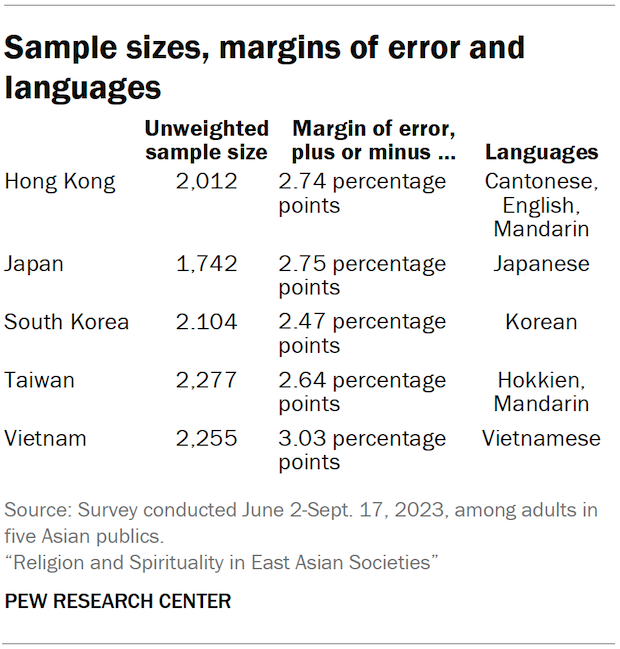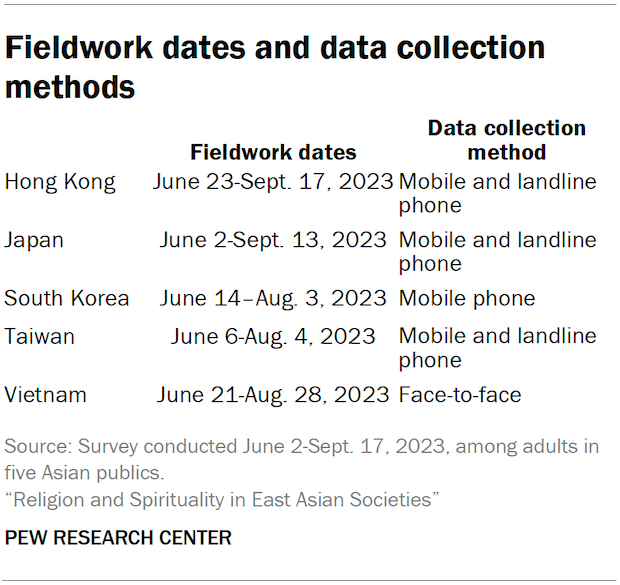Pew Research Center conducted random probability-based surveys among a total of 10,390 adults (ages 18 and older) in five places: Hong Kong, Japan, South Korea, Taiwan and Vietnam. Interviewing in Japan, South Korea and Taiwan was carried out under the direction of Langer Research Associates, and interviewing in Hong Kong and Vietnam was carried out under the direction of D3 Systems. In Hong Kong, Japan, South Korea and Taiwan, interviews were conducted via computer-assisted telephone interviewing (CATI). In Vietnam, interviews were administered face-to-face using tablet devices, also known as computer-assisted personal interviewing (CAPI). All surveys were conducted between June 2 and Sept. 17, 2023.

The surveys were designed to be representative of each adult population, with samples ranging from about 1,750 to 2,300 respondents in each of the places, allowing researchers to analyze the opinions of respondents by age, gender, education and religious affiliation.
The phone surveys were fielded using random-digit-dial (RDD) probability samples based on official numbering plans. In Hong Kong, Japan and Taiwan, respondents were reached on landline and mobile phones. In South Korea, the design was mobile phone only. On landline phones, the Rizzo method was used for within-household respondent selection. On mobile phones, interviews were conducted with the person who answered the phone, if that person was age 18 or older and the phone’s owner. Up to seven attempts were made to complete each interview in Hong Kong, Taiwan, and South Korea; in Japan, up to five attempts were made. In Japan and Hong Kong, nonworking landline and mobile numbers were removed prior to fieldwork. In Taiwan, only nonworking landline numbers were removed.
In Vietnam, the survey was administered using random household selection. The sample was drawn using a multistage cluster design, proportionally stratified by region and urbanicity, and with selection of primary sampling units (PSUs) proportional to total population size. Interview teams were assigned to designated starting points, and they followed a predetermined skip pattern to contact a random selection of households. Within households, the CAPI device randomly selected a respondent to be interviewed from a detailed list of all adult household members. An estimated 11% of Vietnam’s population could not be accessed due to lack of security, language barriers, extreme remoteness, or restrictions by authorities.

The questionnaire was designed by Pew Research Center staff with efforts to ensure the questions would be culturally appropriate and respondents would understand their intended meaning. This included consultation with subject matter experts and project advisers. Early in the development process, eight cognitive interviews were conducted in Japan and Taiwan (four in each place) to test the wording of some questions and concepts. This qualitative work was overseen by Ipsos MORI. The full survey questionnaire was pretested in all five locations prior to fieldwork.
The questionnaire was developed in English and translated into six other languages. Professional linguists with native proficiency independently checked the translations. In questions about belief in “god,” translators were instructed to choose the most generic possible word for god in each language and to avoid terms that refer exclusively to the god(s) or goddess(es) of a particular religion. The final question wording in English and the other survey languages can be found below.
Samples were first weighted to account for differences in respondents’ probabilities of selection, then further raked to match sample distributions of age, gender, education and region (in Vietnam, region by urbanicity) to parameters from the latest census data available for each location. Statistical tests of significance are adjusted to account for the survey’s design (e.g., cluster sampling in Vietnam) and weighting applied (e.g., selection probabilities and raking to census parameters).
Pew Research Center’s website has more details on location-specific sample designs for this study and general information about our international survey research.
Translation of belief in god question
English: Do you believe in god, or not?
Cantonese: 您信唔信神?
Hokkien: 請問你有信神或是無信神?
Japanese: あなたは神を信じますか、信じませんか。
Korean: 선생님께서는 신을 믿으십니까? 믿지 않으십니까?
Mandarin (Hong Kong): 您是否相信神?
Mandarin (Taiwan): 請問您信不信神?
Vietnamese: Anh/Chị có tin vào thần linh hay không?




